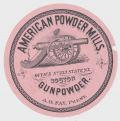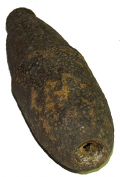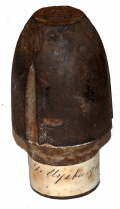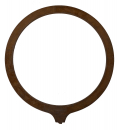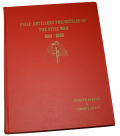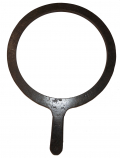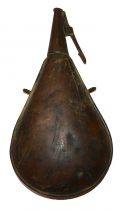site search
online catalog
Artillery
Showing 21 to 40 out of 54
ARTILLERY VENT PUNCH FOR FIELD GUNS
This is a tool for clearing the vent of any obstructions such as pieces of fired friction primers. It has a six-sided head with a hole in the center, and an 8” wire brazed to it. The wire ends with… (1202-471). Learn More »
RARE PACK OF CONFEDERATE, RICHMOND ARSENAL, ARTILLERY FRICTION PRIMERS
Offered here is a very rare, nice condition, original pack of artillery friction primers manufactured at the Richmond Arsenal in Virginia during the Civil War. These “primers” are what was placed… (1268-512). Learn More »
AMERICAN POWDER MILLS BOSTON CIRCULAR LABEL
Measures 6” in diameter. Nice woodcut of a cannon in center; printed on pink paper. Minor damage to each. [ss] [PH:L] ~~~~~~~~~~~~~~~~~~~~~~~~~~~~~~~~~~~ THIS ITEM, AS WITH ALL OTHER ITEMS AVAILABLE… (516-572). Learn More »
$35.00
Originally $44.00
BRITISH ARTILLERY SHIPPING CRATE
This is one of several scarce British artillery crates that recently came to hand, some of which were marked “Quebec.” This is clearly stenciled in black on one end: “11/59” / “W[broad… (2024-1156). Learn More »
BRITISH ARTILLERY SHIPPING CRATE
This is one of several scarce British artillery crates that recently came to hand, some of which were marked “Quebec.” Along with other ordnance and shipping markings, this is clearly stenciled at… (2024-1154). Learn More »
U.S. 3” SCHENKL PERCUSSION SHELL – EAST CAVALRY FIELD, GETTYSBURG - GEISELMAN COLLECTION
This Federal, intact 3” Schenkl percussion shell specimen is a wonderful artillery relic recovered from East Cavalry Field sometime after the Battle of Gettysburg. The percussion shell measures 9”… (2024-2389). Learn More »
ARTILLERY GIMLET FOR 12-INCH GUN – WATERVLIET ARSENAL
The "gimlet" has a screw on the end and was intended to be used to remove broken pieces of friction primers from the vent. It could also serve as a priming wire to poke a hole in the powder bag. This… (2024-2312). Learn More »
STONE MOLD HALF FOR LARGE GRAPE SHOT
This piece is an early mold half for a round grape shot ball. This piece measures approximately 3.5” x 2” x 2.5”. The cavity measures just shy of 2” in diameter. The funnel leading into the… (236-1026). Learn More »
PACK OF FRANKFORD ARSENAL 5-SECOND FUSES
This pack of 5-second artillery fuses originates from the Frankford Arsenal and was produced in 1864. The pack is constructed of a drilled wood block covered with a printed paper label. This paper… (2024-2339). Learn More »
$85.00
SOLD
ARTILLERY VENT PUNCH FOR 12-INCH MORTAR – WATERVLIET ARSENAL
This is a tool for clearing the vent of any obstructions. It has an octagonal head with a hole in the center, and a 21” wire brazed to it. The wire tappers at the end. The flat head is stamped,… (2024-2314). Learn More »
RELIC -- US NAVAL WATERCAP FUSE WITH BUSHING, DATED 1864
Excavated naval watercap fuse dated 1864 and in good condition. This fuse is made of brass with flange on top, with threaded portion and tapered body. A brass bushing is on this fuse to fit into… (2024-2327). Learn More »
3” HOTCHKISS SHELL WITH GETTYSBURG TAG – FROM YORK SPRINGS GAR POST
This shell is part of the collection that was housed at the York Springs GAR Post 551. Many of the items were collected and curated by David Starry, a Civil War veteran who served in an emergency… (1202-230). Learn More »
U.S. ARTILLERY FUSE POUCH MARKED “US”
Very nice condition leather fuse pouch. The leather of the outer flap is in very good condition. There is some crazing on the top “hinge” area of the flap. There is a deep “US” stamp on the… (864-14). Learn More »
1855 DATED 11-INCH SHOT/SHELL GAUGE
These simple iron ring gauges allowed for quick inspection and sorting of shot and shell by size, something of critical importance to a gun crew and a large task given the huge stacks of cannon balls… (490-6754). Learn More »
BRITISH ARTILLERY CRATE FOR 9-POUND SOLID SHOT
The smooth-bore, muzzle-loading 9-pounder cannon was a standard British field-piece in service from 1805 to 1881, with a maximum range of about 1,400 yards and notable service in the Napoleonic Wars… (2024-1155). Learn More »
CONFEDERATE 3” MULLANE COMMON SHELL
Here is a fired Confederate 3” bourreleted Mullane Type 1 common shell recovered from an unknown battlefield location. Made for the 3” Ordnance Rifle. Also known as a “Tennessee Sabot”, this… (490-7005). Learn More »
CIVIL WAR “SPINNER” QUILL PRIMERS FOR NAVAL CANNONS
These Naval cannon primers are constructed using fowl quills; less likely to corrode around salt water. These are percussion, not friction primers. In use, these were ignited by the blow from a… (2024-1521). Learn More »
BOOK – FIELD ARTILLERY PROJECTILES OF THE CIVIL WAR 1861-1865 BY KERKSIS & DICKEY
First edition, hardcover signed by both authors. Limited to 500 numbered copies, this is #303. Text clean and unmarked; 307 pages, 8.5” x 11”. The binding is tight and square. Cover is bright and… (2024-1206). Learn More »
11-INCH SHOT/SHELL GAUGE
These simple iron ring gauges allowed for quick inspection and sorting of shot and shell by size, something of critical importance to a gun crew and a large task given the huge stacks of cannon balls… (490-6807). Learn More »
RARE USN GOSPORT NAVY YARD PRIMING FLASK
Gosport Shipyard was the original name of the facility in Portsmouth, Virginia, that was founded in 1767, passed into the hands of Virginia in the Revolution, was leased from that state by the U.S.… (490-6824). Learn More »
Showing 21 to 40 out of 54
Most Popular
Historical Firearms Stolen From The National Civil War Museum In Harrisburg, Pa »
Theft From Gravesite Of Gen. John Reynolds »
Selection Of Unframed Prints By Don Troiani »
Fine Condition Brass Infantry Bugle Insignia »
Large English Bowie Knife With Sheath 1870’S – 1880’S »
Imported (Clauberg) Us Model 1860 Light Cavalry Officer's Saber »
featured item
WONDERFUL CONDITION ORIGINAL CONFEDERATE-MANUFACTURED KEPI FOR A DRUMMER BOY OR CHILD
This article of uniform clothing is an original, Civil War example of headgear manufactured in the Confederacy and presented here in wonderful, original intact condition. The period artifact is a small, dark blue colored, wool kepi, suited for a… (526-68). Learn More »





